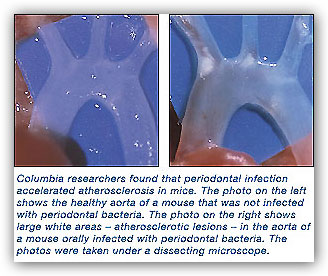|
In the early 1990s, researchers found that gum disease may increase a person's risk of artery disease or atherosclerosis. But the severity of that risk and the mechanisms behind it remain largely
unknown.
Now, researchers at Columbia's School of Dental and Oral Surgery and P&S have received a five-year, $1 million grant from the National Institute of Dental and Craniofacial Research to find answers to these questions.
The grant comes in the wake of studies that increasingly point to infections — along with high blood sugar, homocysteine and blood pressure levels — as risk factors for blood vessel inflammation and hardening.
Periodontal disease is a chronic inflammatory disease affecting the tissues surrounding and supporting the teeth, caused by the bacteria of dental plaque. The severe forms of chronic periodontitis — where destruction of connective tissue attachment and bone can eventually lead to tooth loss — affect approximately 10 percent to 15 percent of individuals in most populations.
The researchers, led by Dr. Evanthia Lalla, associate professor of dentistry, are studying the link in mice to track gum disease and atherosclerosis from inception through their later stages. They will examine markers of vascular inflammation and dysfunction in the blood and different cell types in the mouth, heart and blood vessels.

"We want to see which vascular and inflammatory cells are involved, at which phases, and how," Dr. Lalla says. The researchers hope the study will clarify how gum disease helps trigger atherosclerosis.
Some scientists maintain that bacteria from the gum infection get into the bloodstream and spread the infection, damaging the vessels directly.
Others hypothesize that the host's attempt to fight the oral infection triggers an immune inflammatory response throughout the body that leads to acceleration of atherosclerosis.
Dr. Lalla suspects a combination of the two may be responsible.
Her collaborators on the project are Dr. Ann Marie Schmidt, professor of surgery at P&S; Dr. Panos Papapanou, professor of dentistry at SDOS, Dr. Ira B. Lamster, dean of SDOS, Dr. Vivette D'Agati, professor of pathology at P&S, and Dr. Shi Fang Yan, assistant professor of surgery at P&S.
The new study is an expansion of a pilot study, published in the August issue of Arteriosclerosis, Thrombosis, and Vascular Biology, which reported on a model of oral infection in atherosclerosis-prone mice. The mice lack the apoE gene, which makes a protein important for transporting cholesterol and other fats through the bloodstream. The apoE-null mice, therefore, have high cholesterol, which lingers in the blood and leads to the development of atherosclerotic lesions in their blood vessels that are similar in shape and distribution to those found in humans.
In the pilot study, the researchers compared two groups of mice that were identical except one group of mice were orally infected with the major periodontal pathogen, P. gingivalis. The investigators found the infected mice had more atherosclerosis and developed a systemic inflammatory response, as indicated by elevated antibody and vascular and systemic inflammation marker levels. They also detected P. gingivalis in the vessels of a limited number of the infected mice. These findings suggest that oral infection with P. gingivalis hastens early atherosclerosis.
"Our new studies will show us the relevant pathways and potentially how to lower this risk of atherosclerosis," Dr. Lalla says. "We hope that what we learn from the studies in mice will help us understand and address an individual's risk for atherosclerosis."
Source
Columbia University Medical Center
See also
Healthy gums for healthy blood vessels (24/06/2011)
(MDN)
|
![]()